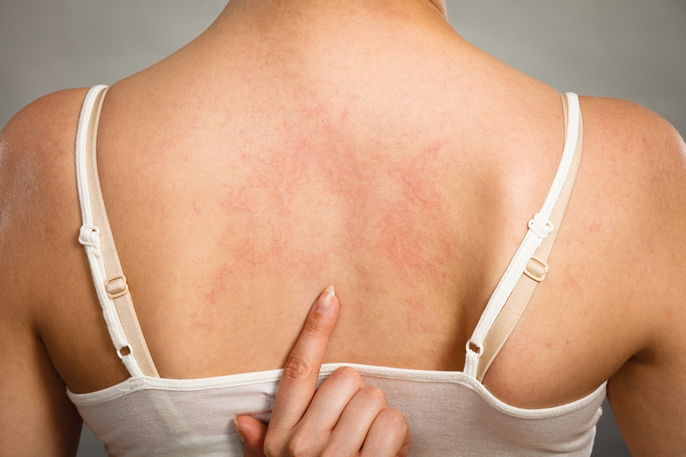Cholinergic urticaria is a condition associated with hives that appear when body temperature increases. It causes symptoms such as itching and/or stinging sensations on the skin, red spots on the trunk and swelling in parts of the body.
Cholinergic urticaria can also be triggered by situations that cause changes in the skin, such as a sweat allergy or other skin irritations.
If you suspect you may have cholinergic urticaria, you are advised to consult a dermatologist. Although there is no cure for this condition, treatment is usually carried out with antihistamines as prescribed by your doctor.

Main symptoms
The main symptoms of cholinergic urticaria are:
- Itching and/or stinging sensation on the skin
- Small lumps, plaques and/or red spots on the body
- Swelling in parts of the body such as the lips, eyes or throat, also known as angioedema
- Cough or shortness of breath;
- Stomach pain, nausea or diarrhea;
- Low blood pressure.
Typically, the symptoms of cholinergic urticaria are caused by an increase in body temperature, which can happen due to physical exercise, hot baths and, in some people, stress, and consumption of hot drinks or spicy foods.
Skin lesions are most common on the trunk, and rarely affect the palms of the hands, soles of the feet or armpits. It tends to improve quickly within 15 minutes to 1 hour.
In more serious cases, cholinergic urticaria can cause symptoms such as body swelling, low blood pressure or shortness of breath. These are signs of angioedema or anaphylaxis, which are more serious allergic reactions.
Confirming a diagnosis
The diagnosis of cholinergic urticaria is confirmed by a dermatologist who assesses the characteristics of the skin lesions and their reaction to increases in body temperature.
The dermatologist can also perform the stress test to confirm the diagnosis, which consists of triggering an increase in body temperature through physical exercise or a hot bath.
Heat rash is a type of skin reaction to heat that can sometimes be confused with cholinergic urticaria, but which happens when sweat clogs and inflames the pores, causing lumps and itchy skin. Learn more about a heat rash and what symptoms look like..
Possible causes
Cholinergic urticaria is believed to be caused by abnormal findings in the skin such as blocked pores, sensitivity to inflammatory substances present in sweat and an abnormal reaction to the release of the neurotransmitter acetylcholine when body temperature rises.
Treatment options
Although there is no cure, cholinergic urticaria is usually treated with anti-allergy medications, such as hydroxyzine and cetirizine, to alleviate symptoms and should be used in accordance with the dermatologist's instructions.
The doctor may also recommend the use of corticosteroid medications directly into the vein, immunobiologicals, such as omalizumab, and desensitization therapy, which consists of exposing the person to their own sweat to stimulate the body's adaptation and alleviate the allergy.
Additionally, for some people, taking steps to reduce stress, such as relaxing and getting enough sleep, and avoiding alcohol or hot drinks and spicy foods, for example, can help control hives.
Home treatment for cholinergic urticaria
Natural treatment for cholinergic urticaria can be carried out to complement the treatment indicated by the doctor, with some options being cold compresses made from chamomile, pansy plants or flaxseed porridge, as they have anti-inflammatory properties, for example. Check out ARTICLE MAPPED FOR EN: more home remedy options for skin allergies.






























